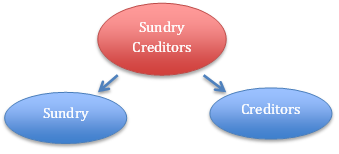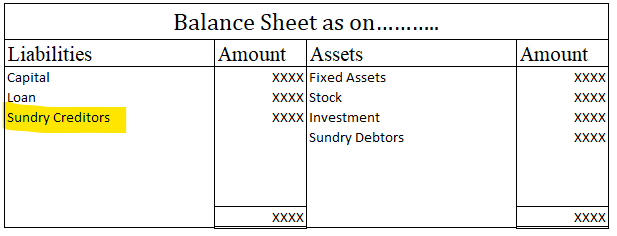Meaning The term ‘Sundry creditors’ consist of two words: ‘Sundry’ and ‘creditors’. The word ‘sundry’ means the items which are not significant enough to be named separately. It also refers to a collection of miscellaneous items. Creditors are the person from whom money is borrowed or goods are puRead more
Meaning
The term ‘Sundry creditors’ consist of two words: ‘Sundry’ and ‘creditors’.

The word ‘sundry’ means the items which are not significant enough to be named separately. It also refers to a collection of miscellaneous items.
Creditors are the person from whom money is borrowed or goods are purchased on credit by a business or a non-business entity. They have to be repaid after a period of time which is usually less than or up to one year.
By combining the meaning of both words, ’sundry’ and ‘creditor’, the term ‘sundry creditor’ will refer to the collection of insignificant creditors of an entity.
Back in the days when accounting records were maintained on paper, only the records of those creditors were maintained separately, from whom goods are purchased regularly and in large amounts.
But there used to be numerous other creditors with whom the transactions were occasional and insignificant. To reduce the paperwork, records of all such creditors were maintained on a single page or book under the head ‘Sundry Creditors’
Nowadays, as accounting records are maintained digitally, hence maintaining records of each and every creditor is not a problem.
Hence, every creditor whether small or big, is grouped under the head ‘Sundry creditor’ or ‘Trade Creditor’.
Accounting Treatment
Sundry creditors are the persons to whom a business owes money.
Hence, as per golden rules of accounting, Sundry creditor is a personal account and the golden rule for personal account is, ‘Debit the receiver and credit the giver’
We know sundry creditors are liabilities, hence, as per modern rule of accounting, sundry creditors are credited in case of increase and debited in case of decrease.
Example, a business purchased goods for Rs. 10,000 from ABC & Co. The journal entry will as follows:

Here, ABC & Co is the creditor. It is credited as it is a personal account and the creditor has given the goods to the business, hence the giver is credited.
From point of view of modern rules of accounting, ABC & Co. is a creditor, a liability. On purchase of goods on credit, a liability is created. Hence, ABC & Co A/c is credited.
Balance sheet
Sundry creditor is a current liability, so it is shown on the liabilities side of a balance sheet. Trade payable and accounts payable mean sundry creditors only.














Before we jump in the concept of valuation of Goodwill, let us first understand the meaning of term “Goodwill”. Goodwill is an Intangible asset of the business. As the definition of Intangible asset, Goodwill cannot be seen or felt. In simple words it is business’s worth or its reputation earned oveRead more
Before we jump in the concept of valuation of Goodwill, let us first understand the meaning of term “Goodwill”.
Goodwill is an Intangible asset of the business. As the definition of Intangible asset, Goodwill cannot be seen or felt. In simple words it is business’s worth or its reputation earned over a period of time.
Calculation of value of the goodwill in monetary terms is done at the time of merger or acquisition of the business. Goodwill is often applied to businesses which are earning large number of profits, have crucial corporate links and large customer/client base.
Self-earned goodwill is never shown in monetary terms in business’s own balance sheet while goodwill which is purchased is shown in the asset side of the balance sheet of the buyer business.
Following are the methods under which goodwill can be valued:
Goodwill = Average Profit x No. of Years Purchase
Goodwill = Weighted Average Profit x No. of Years Purchase
Where,
Weighted Average Profit = Sum of Profits multiplied by weights / Sum of Weights
Formula for the same would be as follows:
Goodwill = Super Profits x (100/Normal Rate of Return)
Formula for the same would be as follows:
Goodwill = Super Profit x Discounting Factor
Formula for the same would be as follows:
a. Average Profit Capitalization Method –
Goodwill = [Average Profit / Normal Rate of Return x 100] – Capital Employed
b. Super Profit Capitalization Method –
Goodwill = Super Profits x (100/ Normal Rate of Return)
See less